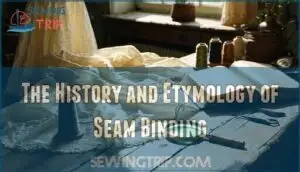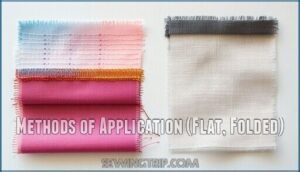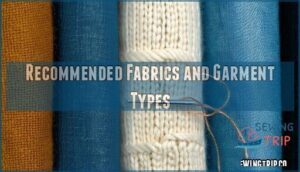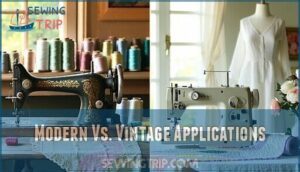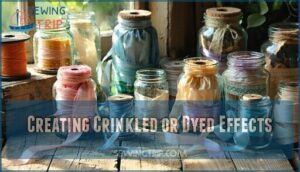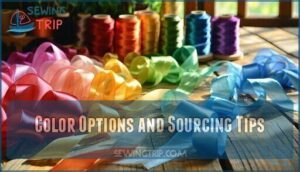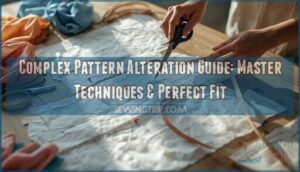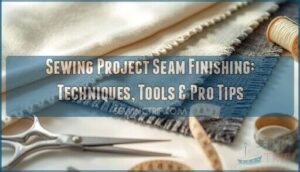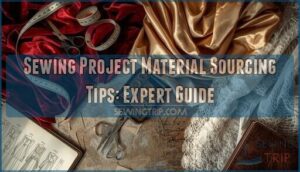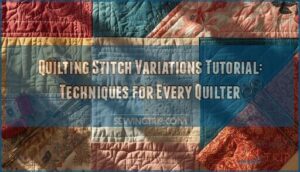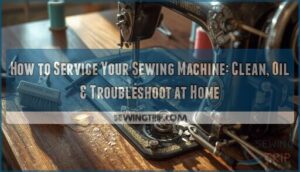This site is supported by our readers. We may earn a commission, at no cost to you, if you purchase through links.
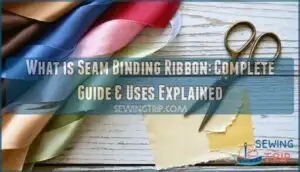
Made from rayon, cotton, or nylon, it transforms unfinished edges into professional-looking results that won’t unravel after washing. Think of it as your fabric’s bodyguard – it keeps everything neat and tidy.
This versatile ribbon works beautifully on everything from vintage dresses to modern jackets – it’s one of those sewing notions that earns its keep in any project box.
Master a few basic application techniques and you’ll see the difference it makes in your finished pieces.
Table Of Contents
Key Takeaways
- You’ll use seam binding ribbon as a narrow woven tape to cover raw fabric edges, preventing fraying and adding professional stability to your garments.
- You can choose from rayon, cotton, or nylon materials – rayon offers the best drape and color retention, while nylon provides superior durability for high-stress applications.
- You’ll apply it using either flat application for lightweight fabrics or folded application for heavier materials, transforming amateur-looking seams into polished results.
- You’ll find it works on medium to heavyweight fabrics like wool coats and denim jackets, plus it’s perfect for vintage garment construction and modern technical textiles.
What is Seam Binding Ribbon?
Seam binding ribbon is a narrow woven tape you’ll use to finish raw edges and reinforce seams in your garments.
This handy notion, usually made from rayon, cotton, or nylon, prevents fraying while adding stability to hems and seam allowances in skirts, pants, and other sewn items.
Definition and Purpose in Sewing
Think of seam binding ribbon as your fabric’s best friend in garment construction. This narrow tape wraps around raw seam allowances, stopping fraying in its tracks and keeping your garments looking sharp for years.
You’ll reach for it when working with medium-weight fabrics that need clean, finished edges—especially when you don’t have a serger handy. Seam binding works across different fabric types, giving you professional-looking seam finishes that actually last through wear and washing.
Common Materials Used (Rayon, Cotton, Nylon)
Three materials really stand out when you’re shopping for seam binding. Rayon tops the list for most sewers – it drapes beautifully and holds color like a dream. Cotton brings that natural breathability we all love, though it won’t give you much stretch. For projects that need serious durability, nylon steps up with impressive strength.
- Rayon seam binding – Smooth finish, takes dye beautifully, moderate cost
- Cotton varieties – Natural fiber properties, breathes well, traditional choice
- Nylon options – Greater strength, elastic recovery, moisture-resistant
- Material blends – Combines fiber properties for enhanced performance
- Specialty textiles – Eco-friendly alternatives, recycled content available
Key Features and Benefits
Beyond material composition, rayon seam binding delivers impressive Durability Enhancement and Fray Prevention for fabric edges. You’ll find Seam Stabilization particularly valuable when working with stretchy knits or delicate materials.
Hug Snug Rayon Seam Binding offers Multiple Applications across garment types while maintaining clean Aesthetic Appeal. These seam finishing techniques transform raw, unfinished edges into professional-looking results that withstand repeated washing and wear.
The History and Etymology of Seam Binding
You’ll discover that the word "seam" comes from Old English "sēam," which connects directly to "sīwian," meaning to sew.
Before modern sergers revolutionized garment finishing in the 1970s, seam binding served as the go-to method for covering raw fabric edges and preventing fraying in professional tailoring.
Origins of The Term Seam
Words carry history in unexpected ways. Take "seam" – it started as the Old English "sēam," meaning "to sew." The word spread through Germanic languages as textile techniques moved across medieval Europe, showing how practical skills shaped our vocabulary.
- Old English roots: "Sēam" originally meant "to sew," showing the word’s Germanic connections
- Cultural significance: The term evolved as sewing techniques spread across medieval Europe
- Textile origins: Early word history demonstrates how seam binding emerged from practical needlework needs
Historical Use in Garment Construction
Before sergers revolutionized garment finishing, seamstresses relied on seam binding for stabilizing raw edges. This pre-serger era demanded careful vintage garment construction using traditional sewing techniques. Historical material types included cotton and rayon bindings that provided essential seam durability history.
Evolution of Seam Binding Materials
Fabric selection transformed dramatically as seam binding evolved from simple cotton strips. By the 1950s, rayon seam binding dominated, offering enhanced drape for vintage garment construction. The full leather bindings of the 18th century share a history of material evolution.
Material durability improved through these key developments:
- Fiber Innovations – Synthetic blends enhanced stretch and longevity
- Adhesive Technology – Heat-fusible options simplified application
- Performance Enhancements – Anti-fray coatings reduced wear
- Sustainable Alternatives – Recycled content meets modern demands
Today’s vintage pattern enthusiasts benefit from these advances.
How to Use Seam Binding Ribbon
Seam binding ribbon works best when you place it right over those raw fabric edges that need finishing. A straight stitch or zigzag will secure it nicely.
For lighter fabrics like cotton blouses, try the flat application method. Heavier materials—think wool coats or sturdy denim—often benefit from folding the binding over the edge instead.
Finishing Raw Edges and Seams
Seam binding’s primary job involves edge fray prevention on raw edges of fabric seams. Raw edges get covered completely, preventing unraveling that weakens garments over time.
You’ll achieve bulk reduction while providing seam stabilization for a professional finish. This technique works better than hem binding for interior seams.
Applying seam binding transforms sewing garment seams from amateur-looking to polished results.
Methods of Application (Flat, Folded)
When it comes to seam binding, you’ve got two solid options that work differently depending on what you’re sewing.
- Flat application – Lay the binding right over your raw edges. This works great for lighter fabrics that don’t need heavy-duty treatment.
- Folded application – Wrap that binding around the edge instead. You’ll get maximum reinforcement this way, though it does add some bulk.
- Bias tape alternative – Either method works perfectly as a substitute for hem binding too.
Recommended Fabrics and Garment Types
Medium to heavyweight fabrics work best with seam binding. You’ll find rayon seam binding perfect for stabilizing wool coats, denim jackets, and structured blazers.
Knitwear reinforcement comes naturally when you apply binding to sweater seams. For hem finishes on skirts and pants, choose binding that matches your fabric weight.
Different apparel types benefit from specific applications—casual wear needs durability, while formal garments require clean edges.
Styles, Techniques, and Customization
You can transform basic seam binding ribbon through various styling techniques that range from traditional flat application to modern crinkled textures and custom dye treatments.
Your choice of color, finish, and application method will determine whether your project achieves a vintage look or contemporary aesthetic.
Modern Vs. Vintage Applications
Seam binding sits at an interesting crossroads right now. Modern fabrics need serious stabilizing power, but folks working on vintage pieces want that genuine, period-correct feel you just can’t fake.
What’s interesting is how rayon seam binding keeps winning out for vintage work. That classic drape it gives just can’t be matched by newer materials.
- Vintage durability – Traditional cotton and rayon create authentic period looks
- Modern textiles – Synthetic blends offer enhanced stretch and recovery
- Design aesthetics – Contemporary minimalism vs. ornate vintage detailing
- Reinforcement needs – Technical fabrics require specialized bias tape applications
- Application evolution – Machine techniques now replicate hand-sewn vintage finishes
Creating Crinkled or Dyed Effects
You can transform plain seam binding into something special with crinkle techniques and dyeing methods. Scrunch wet rayon seam binding, then air-dry for textured finishes.
Tea-dyeing creates vintage feel effects on bias tape. Test color fastness before applying treatments.
Fabric paints offer controlled pattern creation. These methods work best on natural fiber seam binding materials.
Color Options and Sourcing Tips
Seam binding’s color palette spans the rainbow, but matching fabrics requires more than luck. Online retailers like JoAnn Fabrics and fabric.com offer extensive selections with bulk discounts.
Color psychology matters—neutrals hide imperfections while contrasting shades create design statements. Grosgrain ribbon provides structure, while dyeing techniques let you customize colors.
Smart sourcing saves money and ensures perfect matches.
Market Trends and Environmental Innovations
The seam binding market is growing fast, with projections showing it could hit $259.90 million by 2032.
You’ll find today’s seam binding market expanding rapidly, with global values projected to reach $259.90 million by 2032.
Manufacturers now prioritize eco-friendly materials like recycled ribbons and bio-based adhesives, while digital quality control systems guarantee consistent production standards.
Growth in The Seam Binding Ribbon Market
The seam binding ribbon market is gaining serious traction across various industries. Market value hit USD 162.09 million in 2024 and could reach USD 259.90 million by 2032.
North America drives much of this regional demand, while expanding applications in automotive and technical textiles reshape the competitive landscape. Popular segments like grosgrain ribbon and twill tape, including established brands like Hug Snug, are riding this wave in the broader fabric-based market.
Regional demand from North America leads growth, while application expansion into automotive and technical textiles drives the competitive landscape. Grosgrain ribbon and twill tape segments, including brands like Hug Snug, benefit from this fabric-based market evolution.
Eco-Friendly Materials and Manufacturing
Manufacturers are embracing greener approaches to seam binding production. Sustainable adhesives replace harsh chemicals, while recycled fibers from plastic bottles create durable cloth finishes. Ethical sourcing ensures fair labor practices throughout supply chains. Low-impact dyes minimize water pollution during fabric processing. These biodegradable options prevent raw edges from fraying without harming ecosystems, addressing shrinkage concerns naturally. Consequently, manufacturers are increasingly focused on sustainable product development.
- Recycled fibers: Transform plastic bottles into high-performance seam binding ribbon
- Plant-based materials: Cotton and Tencel options biodegrade within 60 days in soil
- Water-based adhesives: Eliminate toxic solvents while maintaining strong fabric bonds
Advances in Quality Control and Technology
Beyond sustainable materials, today’s manufacturers embrace state-of-the-art technology to perfect seam binding production. Digital QC systems monitor fabric quality in real-time, while predictive maintenance prevents sewing machine breakdowns. These advances guarantee consistent raw edges finishing and reliable multifunctional binding performance across all production runs.
| Technology | Application | Benefit |
|---|---|---|
| Digital QC Systems | Real-time fabric monitoring | Consistent quality control |
| Predictive Maintenance | Sewing machine optimization | Reduced downtime |
| Bio-Based Adhesives | Eco-friendly binding production | Sustainable manufacturing |
| Recycled Materials Integration | Waste reduction processes | Environmental compliance |
Frequently Asked Questions (FAQs)
Where can I purchase quality rayon seam binding ribbon?
You’ll discover quality rayon seam binding at Ribbon Connections, Amazon [30], and specialty craft stores. Etsy sellers offer extensive color selections. Check local fabric shops for hands-on quality assessment before purchasing.
Can seam binding ribbon be machine washed?
Ironically, something designed to last forever needs gentle care.
Yes, you can machine wash seam binding ribbon, but use cold water and gentle cycles. Heat damages rayon and nylon fibers, causing shrinkage and weakening.
Whats the difference between bias and non-bias binding?
Bias binding is cut diagonally across the fabric grain, giving it stretch and flexibility for curves.
Non-bias binding is cut straight along the grain, making it stable but less flexible for curved seams.
How do you calculate seam binding yardage needed?
Picture measuring every edge that needs a gentle fabric embrace—that’s your starting point! You’ll measure the project’s perimeter, add extra inches for mitering corners and seam allowances, then divide by your fabric’s usable width.
Can seam binding replace traditional hem tape?
You can substitute seam binding for hem tape in most projects. Both serve similar functions, though seam binding works better on curved edges while hem tape excels on straight hems.
Is seam binding suitable for stretch fabrics?
You’ll find seam binding works wonderfully on stretch fabrics when you choose the right type. Look for knit or bias-cut binding that moves with your fabric’s stretch properties.
Conclusion
Like a reliable friend who always has your back, understanding what’s seam binding ribbon enables you to tackle any sewing project with confidence.
Mastering seam binding ribbon gives you the power to transform amateur sewing into professional-grade garments that last
This adaptable tape transforms raw edges into professional finishes, preventing fraying while adding durability to your garments.
Whether you’re working on vintage pieces or modern designs, seam binding ribbon offers endless possibilities for customization. You’ll find it indispensable for achieving clean, lasting results that withstand repeated washing and wear.
- https://ripstopbytheroll.com/products/mil-spec-nylon-grosgrain-ribbon
- https://www.decorativetrimmings.com/12-inch-united-ribbon-seam-binding.html
- https://www.blog.wawak.com/post/how-to-finish-a-hem-with-seam-binding
- https://www.databridgemarketresearch.com/reports/global-seam-tape-market
- https://finance.yahoo.com/news/global-seam-tapes-market-poised-083000348.html

